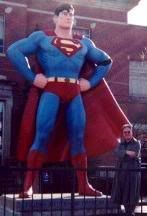| Pop Culture Gadabout | ||
|
Thursday, November 23, 2006 ( 11/23/2006 07:31:00 AM ) Bill S.  "WHAT THE HECK'S A 'ZOMBIE SHOP,' ANYWAY?" – (A "Sixty-Minute Manga" Exploration): Reiko Himezono, the title lead of Rei Mikamoto's awkwardly titled manga series, Reiko the Zombie Shop (Dark Horse Manga), is a teenaged girl with powerful necromantic abilities. Brandishing a palm emblazoned with a "summoning circle," invoking the name of Satan, the shapely high schooler (she's rarely shown wearing anything but her school uniform) raises the dead for a sliding fee. This only occasionally appears to work out well for her customers, since the dead typically rise with some serious unfinished business on their zombie minds. And though our heroine advises her clients to secure their to-be-revived dead ones, this advice is typically ignored. Gory mayhem is the inevitable result: always listen to your necromancer, kids! "WHAT THE HECK'S A 'ZOMBIE SHOP,' ANYWAY?" – (A "Sixty-Minute Manga" Exploration): Reiko Himezono, the title lead of Rei Mikamoto's awkwardly titled manga series, Reiko the Zombie Shop (Dark Horse Manga), is a teenaged girl with powerful necromantic abilities. Brandishing a palm emblazoned with a "summoning circle," invoking the name of Satan, the shapely high schooler (she's rarely shown wearing anything but her school uniform) raises the dead for a sliding fee. This only occasionally appears to work out well for her customers, since the dead typically rise with some serious unfinished business on their zombie minds. And though our heroine advises her clients to secure their to-be-revived dead ones, this advice is typically ignored. Gory mayhem is the inevitable result: always listen to your necromancer, kids!As you might guess from the above, Mikamoto's horror manga is over-the-top and campy, short on logic and long on blood-&-guts. I dug it, but keep in mind I'm a guy who watches Herschell Gordon Lewis flicks on a Sunday morning. Book One of Dark Horse's English translation of this eleven-volume series contains seven stories – one of which apparently was initially serialized in three parts – most of which are given the simple title of "Act." In "Act 3," for instance, a science teacher/mad scientist who has been attempting to clone the body of a girl suicide hires Reiko. Unable to revive her clone because "her desire to die was so great that those desires were imbedded all the way into her DNA," he enlists our heroine's necromantic abilities to zombify the clone. Unfortunately, Reiko's powers also extend to all the other bodies in the general vicinity, which leads to the revival of two decades' worth of failed experiments that the obsessed scientist had walled in his lab. Gory you-know-what ensures, with Mikamato upping the ante on his already outlandish premise by telling us that the cloned girl was pregnant – and so is her clone! (So how does that work, anyway?) Nasty? Wait 'til you see that panel of the zombie fetus bursting out at its "daddy"! This is clearly not a series that's gonna be embraced by the professional culture scolds. Though some small gestures are made toward establishing a supporting cast in the first book (there’s a girl with big glasses who'd appear to be Reiko's "friend" in two of the stories), the primary focus is on our young mercenary necromancer. We're not told much about Reiko except that she's no-nonsense when it comes to business and quite loud about her refusal to do any work for free (though we do get to see her revive a dead puppy). She's unfazed by any of the grisly sights thrown at her in the course of day's work – which in this series can be plenty grisly indeed. In Volume One, we're treated to the sight of a pedophiliac father getting torn in two by a vengeful zombie daughter, several beheadings and a bloody guitar impaling. The book's three-act story centers on a serial killer who searches the city for a new little sister, then slices-&-dices them when they understandably balk at the prospect. When the police call in Reiko to revive one of her victims, Mikamoto shows several close-ups of the little girl's head with an eyeball dangling out of its socket. To be sure, the ultra-gory antics of the book are more Itchy 'N' Scratchy cartoonish than believable. More disturbing are the smaller character details: the girl who kills herself to avoid being further molested by her father or the ambitious reporter who winds up sacrificing bother herself and her daughter in pursuit of the serial killer story. Reiko may be campy, but the material it's playing with is so raw that it occasionally can't help hitting a nerve. Mikamoto's art is slick and effective. He rarely misses an opportunity to contrast his shoujo styled female figures with the gory story action – when the "little sister" killer's identity is revealed, of course, she turns out to be a schoolgirl like Reiko – and his use of shading in the atmospheric sequences is particularly fine. His vengeance-driven zombie attacks (and there are several) are dynamic, and there's a final confrontation between Reiko and that serial that is as knockabout as anything Sam Raimi could concoct. When the battle and the first volume ends, we have to wonder how our heroine is even gonna make it back to Book Two, though obviously she does or the series' title would have to change. But how does Reiko get her head back onto her acid-ravaged body? # | |
|
|

